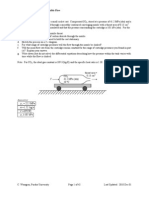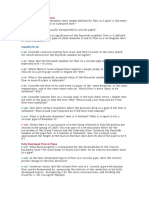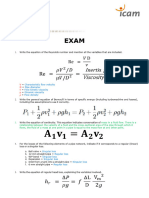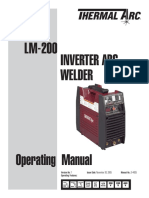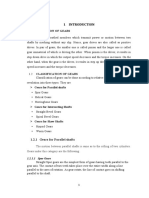FlowLabEOC2e CH06
Uploaded by
tomekzawistowskiFlowLabEOC2e CH06
Uploaded by
tomekzawistowski274 MOMENTUM ANALYSIS OF FLOW SYSTEMS
639 Water enters a centrifugal pump axially at atmospheric pressure at a rate of 0.12 m3/s and at a velocity of 7 m/s, and leaves in the normal direction along the pump casing, as shown in Fig. P639. Determine the force acting on the shaft (which is also the force acting on the bearing of the shaft) in the axial direction.
Blade Impeller shroud n Shaft
642 Water (r 998.2 kg/m3 and m 1.003 103 kg/m s) flows through the 180 curved duct of Prob. 640. A1 A2 0.025 m2. The inlet flow is nearly uniform with b1 1.005, but b2 1.03. Run FlowLab with the template Curved_duct_velocity, specifying inlet velocity in the range of 1 to 40 m/s. For each case, record the inlet velocity, P1,gage, P2,gage, and the net horizontal force Fx of the water on the duct walls, as calculated by FlowLab. Using these pressures and the conservation laws, calculate Fx analytically for each case and compare with the CFD results. Discuss. 643 Water (r 998.2 kg/m3 and m 1.003 3 10 kg/m s) flows through the 180 curved duct of Prob. 641. A1 0.025 m2 and inlet velocity V1 1.0 m/s. The inlet flow is nearly uniform with b1 1.01, but b2 1.03. Run FlowLab with the template Curved_duct_area, specifying area ratios A2 / A1 ranging from 0.4 to 2.0. For each case, record A2 / A1, P1,gage, P2,gage, and the net horizontal force Fx of the water on the duct walls, as calculated by FlowLab. Using these pressures and the conservation laws, calculate Fx analytically for each case and compare with the CFD results. Discuss. 644 As a follow-up to Prob. 640, notice that for a large enough area ratio, the inlet pressure is actually smaller than the outlet pressure! Explain how this can be true in light of the fact that the CFD calculations model friction and other irreversibilities due to turbulence, and pressure must be lost along the axis of the duct to overcome these irreversibilities. 645 An incompressible fluid of density r and viscosity m flows through a curved duct that turns the flow through angle u. The cross-sectional area also changes. The average velocity, momentum flux correction factor, gage pressure, and area are known at the inlet (1) and outlet (2), as in Fig. P645. (a) Write an expression for the horizontal force Fx of the fluid on the walls of the duct in terms of the given variables. (b) Verify your expression by plugging in the following values: u 135, r 998.2 kg/m3, m 1.003 103 kg/m s, A1 0.025 m2, A2 0.050 m2, b1 1.01, b2 1.03, V1 10 m/s, P1,gage 78.47 kPa, and P2,gage 65.23 kPa. (Hint: You will first need to solve for V2.) (c) At what turning angle is the force maximized? Answers: (b) Fx 7700 N to the right, (c) 180
V1 1 P1,gage A1
0.12 m3/S
FIGURE P639
640 An incompressible fluid of density r and viscosity m flows through a curved duct that turns the flow 180. The duct cross-sectional area remains constant. The average velocity, momentum flux correction factor, and gage pressure are known at the inlet (1) and outlet (2), as in Fig. P640. (a) Write an expression for the horizontal force Fx of the fluid on the walls of the duct in terms of the given variables. (b) Verify your expression by plugging in the following values: r 998.2 kg/m3, m 1.003 103 kg/m s, A1 A2 0.025 m2, b1 1.01, b2 1.03, V1 10 m/s, P1,gage 78.47 kPa, and P2,gage 65.23 kPa. Answer: (b) Fx 8680 N to the right
V1 1 P1,gage
A1
Fx
V2 2 P2,gage
A2
FIGURE P640
641 Consider the curved duct of Prob. 640, except allow A2). the cross-sectional area to vary along the duct (A1 (a) Write an expression for the horizontal force Fx of the fluid on the walls of the duct in terms of the given variables. (b) Verify your expression by plugging in the following values: r 998.2 kg/m3, A1 0.025 m2, A2 0.015 m2, b1 1.02, b2 1.04, V1 20 m/s, P1,gage 88.34 kPa, and P2,gage 67.48 kPa. Answer: (b) Fx 30,700 N to the right
Fx
V2, 2, P2,gage,
A2
FIGURE P645
275 CHAPTER 6
646 Water (r 998.2 kg/m3 and m 1.003 3 10 kg/m s) flows through the curved duct of Prob. 645. In this case, V1 1 m/s and A1 A2 0.025 m2. The inlet flow is nearly uniform with b1 1.00, but b2 1.04. Run FlowLab with the template Curved_duct_angle, specifying duct angle u in the of range 30 to 225. For each case, record the turning angle, P1,gage, P2,gage, and the net horizontal force Fx of the water on the duct walls, as calculated by FlowLab. Using these pressures and the conservation laws, calculate Fx analytically for each case and compare with the CFD results. Discuss. At what turning angle does the force reach a maximum? 647 Water of density r 998.2 kg/m3 flows through a firemans nozzlea converging section of pipe that accelerates the flow. The inlet diameter is d1 0.100 m, and the outlet diameter is d2 0.050 m. The average velocity, momentum flux correction factor, and gage pressure are known at the inlet (1) and outlet (2), as in Fig. P647. (a) Write an expression for the horizontal force Fx of the fluid on the walls of the nozzle in terms of the given variables. (b) Verify your expression by plugging in the following values: b1 1.03, b2 1.02, V1 4 m/s, P1,gage 123,000 kPa, and P2,gage 0 kPa. Answer: (b) Fx 583 N to the right
A1 V1 P1 d1 F r x A2 V2 P2
of the bend is 50 cm above the exit. Neglecting any frictional and gravitational effects, determine the net resultant force exerted on the reducer by the water. Take the momentum-flux correction factor to be 1.04. Commercially available large wind turbines have blade span diameters as large as 100 m and generate over 3 MW of electric power at peak design conditions. Consider a wind turbine with a 90-m blade span subjected to 25-km/h steady winds. If the combined turbinegenerator efficiency of the wind turbine is 32 percent, determine (a) the power generated by the turbine and (b) the horizontal force exerted by the wind on the supporting mast of the turbine. Take the density of air to be 1.25 kg/m3, and disregard frictional effects.
25 km/h
651
90 m
FIGURE P651
Angular Momentum Equation FIGURE P647
648 Consider the firemans nozzle of Prob. 647. Assume b1 1.03 and b2 1.01. Run FlowLab with the template Fireman_nozzle_velocity, specifying inlet velocity V1 in the range of 1 to 15 m/s. For each case, record V1, P1,gage, P2,gage, and the net horizontal force Fx of the water on the nozzle walls, as calculated by FlowLab. Using these pressures and the conservation laws, calculate Fx analytically for each case and compare with the CFD results. Discuss. 649 Consider the firemans nozzle of Prob. 647. Assume b1 1.03 and b2 1.01. Run FlowLab with the template Fireman_nozzle_diameter. In this template, inlet diameter d1 0.100 m and inlet velocity V1 1 m/s, but vary the diameter ratio d2/d1 from 0.2 to 0.8. For each case, record d2/d1, P1,gage, P2,gage, and the net horizontal force Fx of the water on the nozzle walls, as calculated by FlowLab. Using these pressures and the conservation laws, calculate Fx analytically for each case and compare with the CFD results. Discuss. 650 Water flowing in a horizontal 25-cm-diameter pipe at 8 m/s and 300 kPa gage enters a 90 bend reducing section, which connects to a 15-cm-diameter vertical pipe. The inlet 652C Consider two rigid bodies having the same mass and angular speed. Do you think these two bodies must have the same angular momentum? Explain. 653C Express the angular momentum equation in scalar form about a specified axis of rotation for a fixed control volume for steady and uniform flow. 654C Express the unsteady angular momentum equation in vector form for a control volume that has a constant moment of inertia I, no external moments applied, one outgo . ing uniform flow stream of velocity V , and mass flow rate m. 655C How is the angular momentum equation obtained from Reynolds transport equations? 656 Water enters vertically and steadily at a rate of 35 L/s into the sprinkler shown in Fig. P656 with unequal arms and unequal discharge areas. The smaller jet has a discharge area of 3 cm2 and a normal distance of 50 cm from the axis of rotation. The larger jet has a discharge area of 5 cm2 and a normal distance of 35 cm from the axis of rotation. Disregarding any frictional effects, determine (a) the rotational speed of the sprinkler in rpm and (b) the torque required to prevent the sprinkler from rotating.
You might also like
- Viscous Dissipation Term in Energy EquationsNo ratings yetViscous Dissipation Term in Energy Equations14 pages
- Cec 107 Practical - Introduction To Fluid Mechanics100% (1)Cec 107 Practical - Introduction To Fluid Mechanics28 pages
- EML4304C - : Be Sure To Follow The Homework Format As Shown On The Website!No ratings yetEML4304C - : Be Sure To Follow The Homework Format As Shown On The Website!4 pages
- Applications of The Momentum Principle - Hydraulic Jump, Surge and Flow Resistance Open Channels100% (1)Applications of The Momentum Principle - Hydraulic Jump, Surge and Flow Resistance Open Channels44 pages
- Turbulent Compressible Flow in A Slender Tube PDFNo ratings yetTurbulent Compressible Flow in A Slender Tube PDF6 pages
- National University of Singapore Department of Mechanical Engineering ME 2134-Fluid Mechanics: PART 2 (2017) (Tutorial Sheet 2)No ratings yetNational University of Singapore Department of Mechanical Engineering ME 2134-Fluid Mechanics: PART 2 (2017) (Tutorial Sheet 2)5 pages
- Compressible Flow Bench: Yeditepe University Department of Mechanical EngineeringNo ratings yetCompressible Flow Bench: Yeditepe University Department of Mechanical Engineering5 pages
- Numerical Modeling of The Performance of A Centrifugal Compressor Impeller With Low Inlet Flow CoefficientNo ratings yetNumerical Modeling of The Performance of A Centrifugal Compressor Impeller With Low Inlet Flow Coefficient13 pages
- MEC222 - 5 Fluid Mechanics QP - Amrita UniversityNo ratings yetMEC222 - 5 Fluid Mechanics QP - Amrita University4 pages
- Wetted Perimeter: N (Ref. 1 Table 10.1) NNo ratings yetWetted Perimeter: N (Ref. 1 Table 10.1) N8 pages
- CHE 253M Experiment No. 3 Liquid Flow MeasurementNo ratings yetCHE 253M Experiment No. 3 Liquid Flow Measurement12 pages
- Advanced Thermo and Fluid Mech 2024 Exam Marking Scheme final CopyNo ratings yetAdvanced Thermo and Fluid Mech 2024 Exam Marking Scheme final Copy12 pages
- Reference Guide To Useful Electronic Circuits And Circuit Design Techniques - Part 2From EverandReference Guide To Useful Electronic Circuits And Circuit Design Techniques - Part 2No ratings yet
- The Mechanics of Water-Wheels - A Guide to the Physics at Work in Water-Wheels with a Horizontal AxisFrom EverandThe Mechanics of Water-Wheels - A Guide to the Physics at Work in Water-Wheels with a Horizontal AxisNo ratings yet
- Hydraulic Tables; The Elements Of Gagings And The Friction Of Water Flowing In Pipes, Aqueducts, Sewers, Etc., As Determined By The Hazen And Williams Formula And The Flow Of Water Over The Sharp-Edged And Irregular Weirs, And The Quantity DischargedFrom EverandHydraulic Tables; The Elements Of Gagings And The Friction Of Water Flowing In Pipes, Aqueducts, Sewers, Etc., As Determined By The Hazen And Williams Formula And The Flow Of Water Over The Sharp-Edged And Irregular Weirs, And The Quantity DischargedNo ratings yet
- 1970-Petukhov - Heat Transfer and Friction in Turbulent Pipe Flow With Variable Physical PropertiesNo ratings yet1970-Petukhov - Heat Transfer and Friction in Turbulent Pipe Flow With Variable Physical Properties62 pages
- Transient Heat Transfer Analysis On A Satellite in OrbitNo ratings yetTransient Heat Transfer Analysis On A Satellite in Orbit5 pages
- Satellite Thermal Control Engineering: Prepared For "SME 2004"No ratings yetSatellite Thermal Control Engineering: Prepared For "SME 2004"0 pages
- Dynamic Stress Analysis of A Bus SystemsNo ratings yetDynamic Stress Analysis of A Bus Systems10 pages
- Applications of Partial Differential EquationsNo ratings yetApplications of Partial Differential Equations8 pages
- Doaa Article Presentation Media LiteracyNo ratings yetDoaa Article Presentation Media Literacy23 pages
- Automatic SQL Injection Tool - Sqlmap - Linux BlogNo ratings yetAutomatic SQL Injection Tool - Sqlmap - Linux Blog3 pages
- Supply Chain Management: An International Journal: Article InformationNo ratings yetSupply Chain Management: An International Journal: Article Information15 pages
- Ict - Telecom Osp Installation (Fiber Optic Cable) NC Ii PDFNo ratings yetIct - Telecom Osp Installation (Fiber Optic Cable) NC Ii PDF15 pages
- Unit-1 - Technology of Meat, Fish, Poultry & Their ProductsNo ratings yetUnit-1 - Technology of Meat, Fish, Poultry & Their Products11 pages
- Dhananjay Sharma Vs State of Haryana and Ors On 2 May, 1995No ratings yetDhananjay Sharma Vs State of Haryana and Ors On 2 May, 199521 pages
- Push-In Thermocouples With Terminal Head Form A: Technical DataNo ratings yetPush-In Thermocouples With Terminal Head Form A: Technical Data4 pages
- Series 90 130 CC Axial Piston Motor: Parts ManualNo ratings yetSeries 90 130 CC Axial Piston Motor: Parts Manual28 pages
- (Ebooks PDF) Download (Ebook PDF) Understanding Patent Law, Third Edition 3rd Edition Full Chapters100% (3)(Ebooks PDF) Download (Ebook PDF) Understanding Patent Law, Third Edition 3rd Edition Full Chapters51 pages
- Motivational Strategies Followed in Accenture0% (1)Motivational Strategies Followed in Accenture10 pages
- GS 08 50208 SMDS Wax Plant Expansion PPD RevB1 PDFNo ratings yetGS 08 50208 SMDS Wax Plant Expansion PPD RevB1 PDF28 pages
- Upper Assam Road Trip Visiting Namsai ArunachalNo ratings yetUpper Assam Road Trip Visiting Namsai Arunachal1 page























